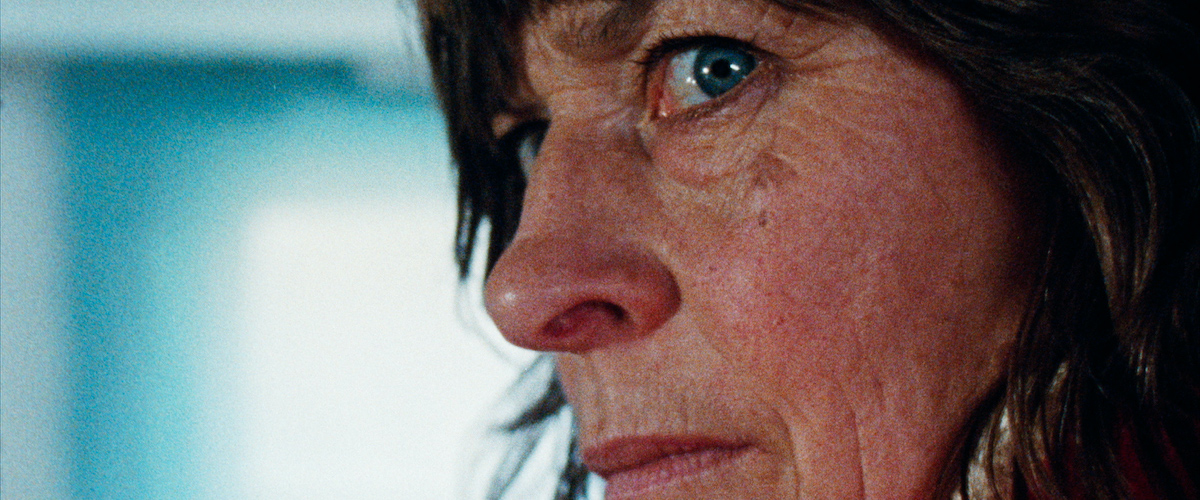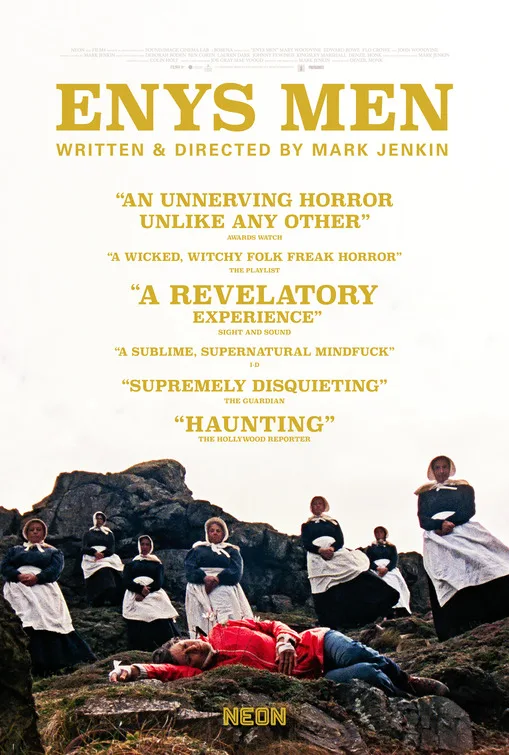“No change.” “No change.” “No change.” “No change.” Every day, the woman (Mary Woodvine) makes a note in a ledger book about a certain flower she’s observing, a white flower clinging to the side of a rocky cliff. Days pass. “No change.” Until one day, there’s a change. The entire page listing “No change” is in stark contrast to the woman’s daily experiential reality, as well as our experiential reality watching “Enys Men,” Mark Jenkin’s second feature film. Every moment appears to be in a state of cataclysmic flux, so much so that it’s not clear what is real and what isn’t. In the face of all the evidence, “No change” takes on an ominous resonance.
“Enys Men” means “stone island” in Cornish, and the film takes place entirely on a stony island surrounded by a heaving spectacular sea. The surf crashes and seethes against the cliffs, and the landscape is rough, with patches of shifting spongy moss and rock outcroppings in weird shapes. The woman is alone on the island, living in a small stone house, doing daily tasks, the same tasks in the same order. Is she a naturalist or a botanist with a grant to study the flora and fauna of this island? There’s no real explanation of what she’s doing. The year is 1973, we know that from the ledger book. Her entries are all for the month of April, leading up to May 1st. May Day. Or maybe it’s “M’aider.” She lies in bed at night, reading by candlelight, reading Edward Goldsmith’s influential 1972 ecological warning bell A Blueprint for Survival. Supplies come by boat every couple of weeks. Her generator is acting up. She’s getting low on coffee grounds.
Shot on 16mm, “Enys Men” crackles with grain, giving it an authentic “found object” feel. It looks like it was actually shot in 1973. Jenkin utilizes familiar visual devices, “out of style” now, but extremely effective, placing “Enys Men” in its 1970s environment: long slow zooms in and out, disorienting shot construction (it’s hard to get a feel for where things are happening, spatially), and even more disorienting edits. The shots move with alarming suddenness from an extreme closeup to a vast panorama, where you can barely find the woman in the frame, and the effect is dizzying.
Some of this is monotonous, but it’s monotonous by design. Every day she starts her generator. She has some coffee. Then she sets out. She walks to the seaside cliffs to monitor the flowers growing there, startling white flowers with bright scarlet stamens. They’re rather alarming-looking. She makes measurements. She then goes to an open well near a round tower and tosses a rock down into the depths, listening for the sound of the splash. She walks out into the middle of the field across from her front door, where stands a giant rock in the shape of a pointed spearhead. She’s drawn to the rock as to a magnet. She returns to her house to make a note in her ledger: “No change.”
But everything is changing. There are times when it’s not clear whether or not she is alone on this lonely island. Figures appear. A white-haired man is standing outside at night. A woman stands on her roof. Or shows up in the next room. There are moments when she is suddenly surrounded by seven girls, all wearing white hoods and white aprons. Underground, in the dripping rocky darkness, miners cluster, staring up at her, candles attached to their helmets. Ghosts of the past residents of the island? A yellow raincoat seems to suggest a man was here, maybe there was a boat crash. Maybe the pointed rock in the middle of the field is a magnetic force, vibrating with energies past and present. The sound design amplifies the minute (her boots scraping against pebbles), and silence suddenly booms. The radio crackles to life with indecipherable messages.
“Enys Men” doesn’t explain itself. This may be frustrating for some. I found it compelling, not just stylistically but emotionally. It called to mind, on some level, Chantal Akerman’s “Jeanne Dielman, 23, quai du commerce, 1080 Bruxelles,” in its devotion to repetition, in its patience in noticing small changes, in breaking down the routine into something strange, even threatening. There’s tension in the monotony. When change comes, it drops from the sky like a menacing anvil.
Lichen is a central symbol of “Enys Men,” deep and rich in its potential multiple meaning. Lichen proliferates across the island, an unstoppable force, breaking apart rocks, and clambering over vertical stony walls. Jenkin goes back to it again and again, shots of it pushing through boulders, sticking out of the sides of the cliff. Lichen is mysterious. It looks like a plant, but it’s not a plant. It’s not fungi, either. It doesn’t adhere to strict categories. In “Gaia,” a 2021 eco-horror film, a giant fungus takes over a jungle, and also the humans unfortunate enough to be trapped in the perimeter, with a woman basically sprouting mushrooms out of her skin. There’s a similar sense of an irresistible force in “Enys Men,” perhaps supernatural, perhaps natural.
What all of this means is never stated outright. Things don’t “add up.” That’s fine with me. I was riveted by every moment of this haunting weird film. “Enys Men” made me legitimately uneasy.
Not every movie sends you down a Google rabbit hole on a quest to learn more about lichen. Apparently, I have taken lichen for granted all this time. I know what it is, but I don’t know what it IS. In Googling around for information, I tripped over a beautiful poem by Jane Hirshfeld called “For the Lobaria, Usnea, Witches Hair, Map Lichen, Beard Lichen, Ground Lichen, Shield Lichen.” Hirschfeld refers to lichen as the “marriage of fungi and algae” and calls it “chemists of air.”
“When I saw you, later, seaweed reefed in the air,
you were grey-green, incomprehensible, old …
Transformers unvalued, uncounted.
Cell by cell, word by word, making a world they could live in.”
“Enys Men” takes place in the borderland of transformation, where past and present (and a terrifying future) co-exist, where boundaries blur, and where “No change” is ominous because if there’s one constant in the universe, it’s that everything changes. The woman’s reading material speaks to the overall anxiety of humans’ desire to make “a world they can live in.” Maybe it’s already too late.
Now playing in theaters.




















